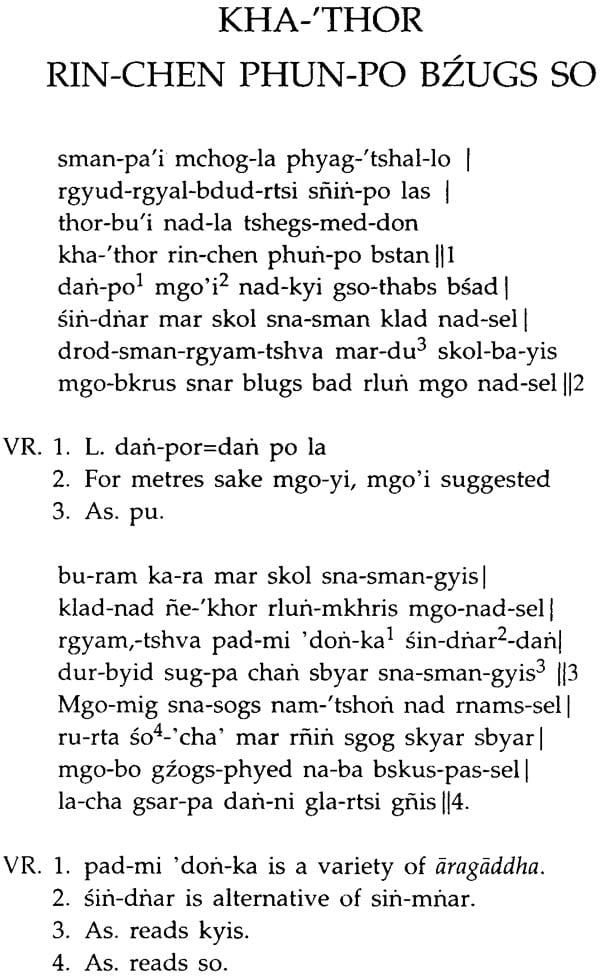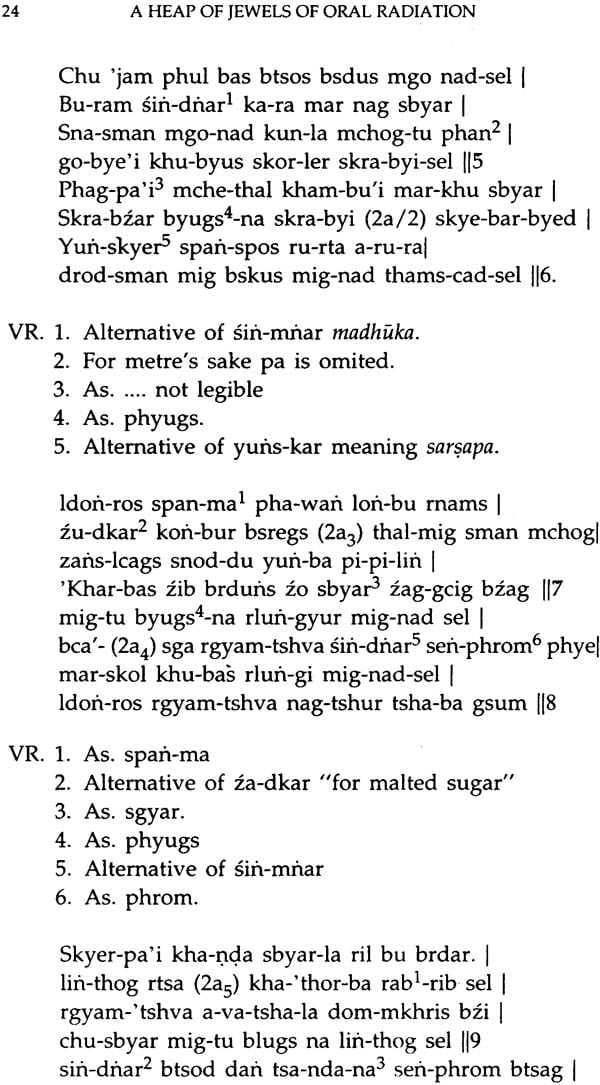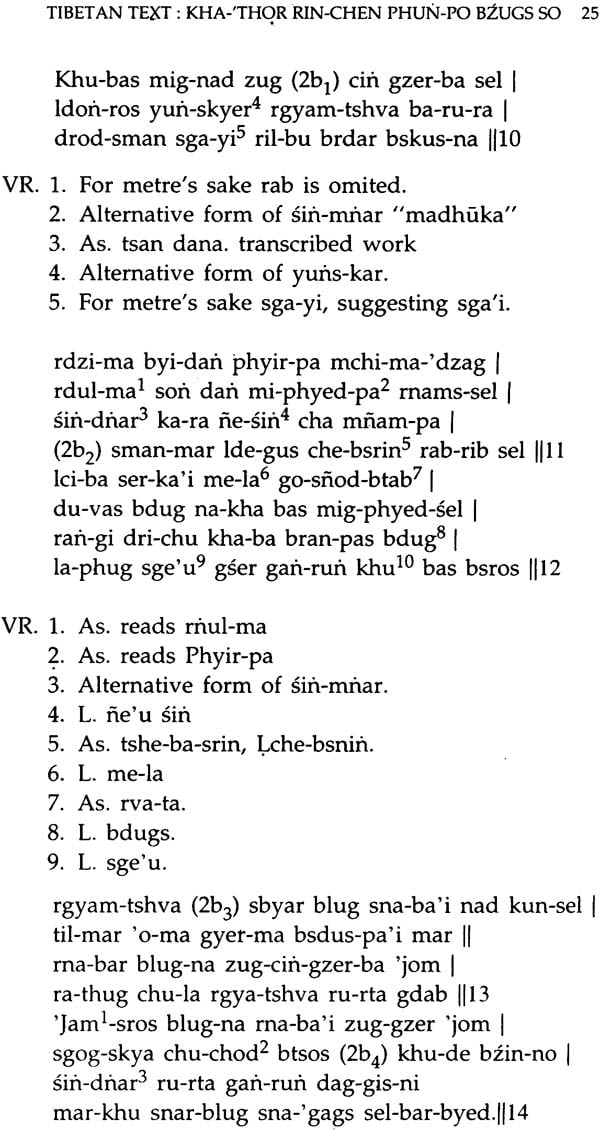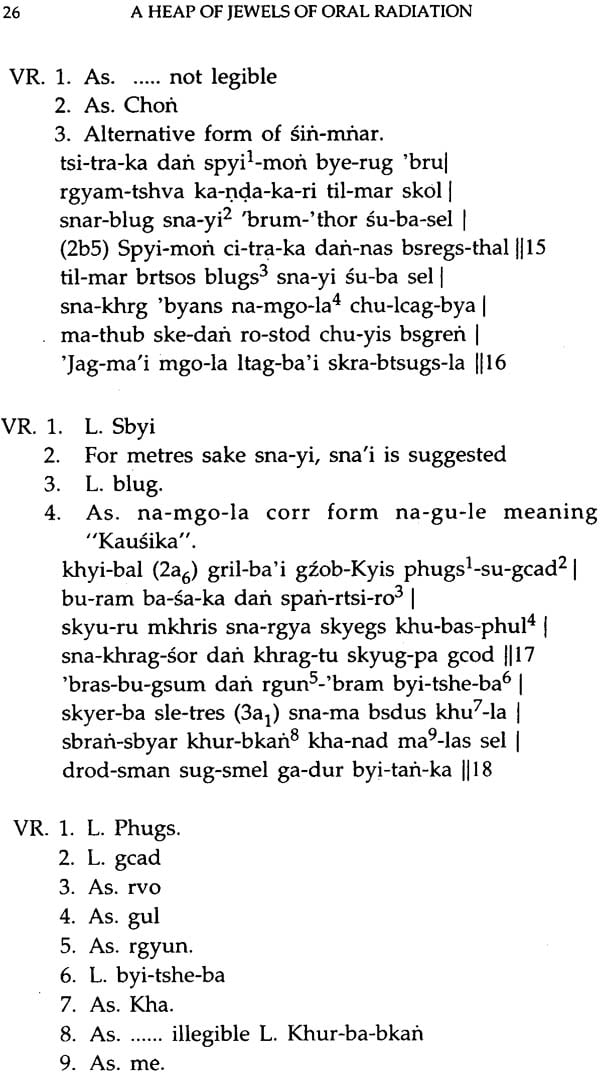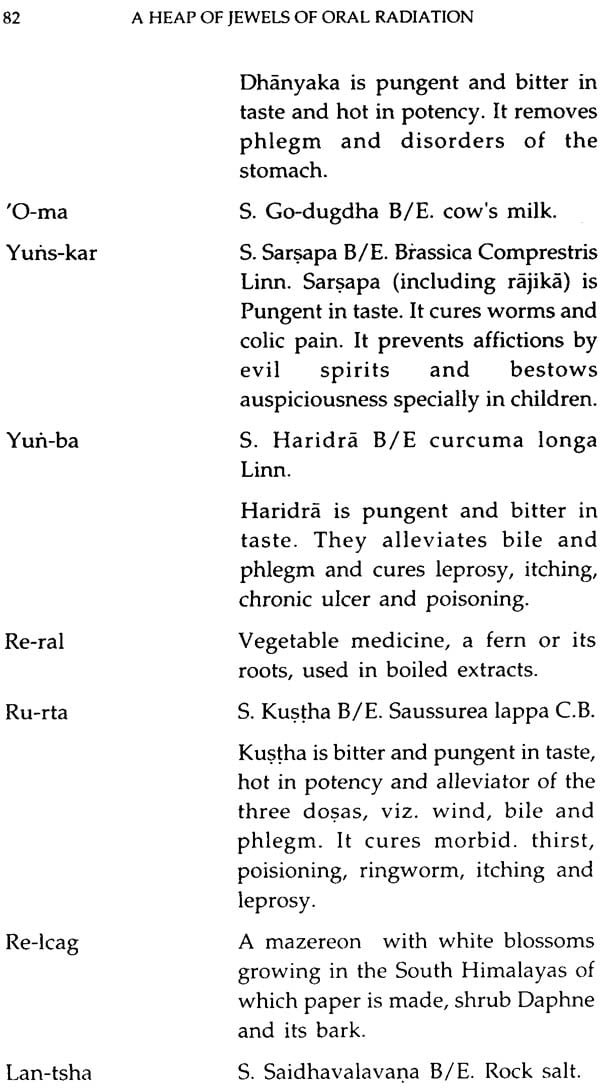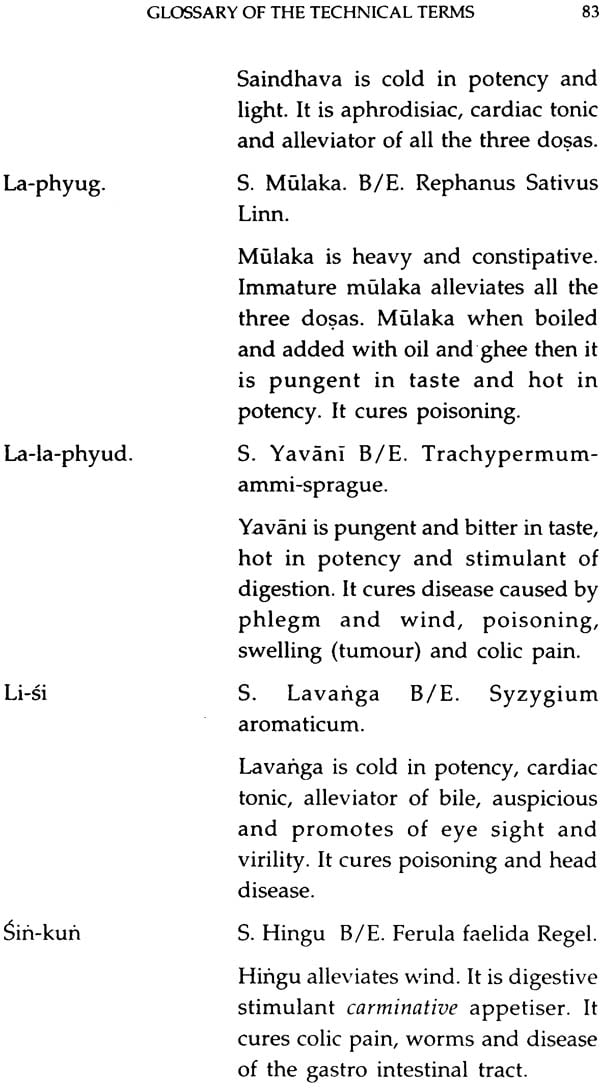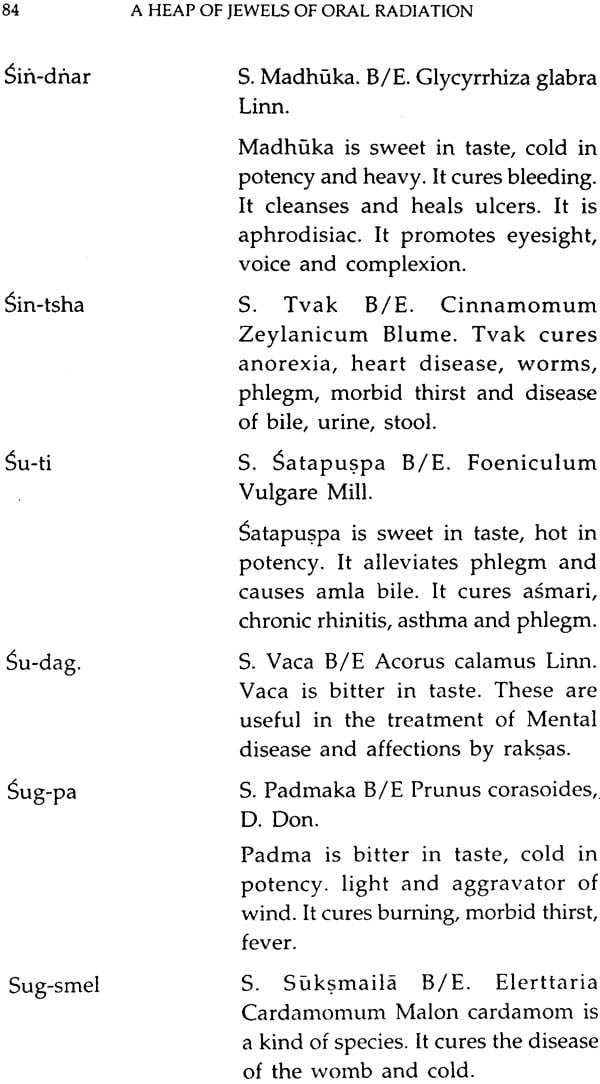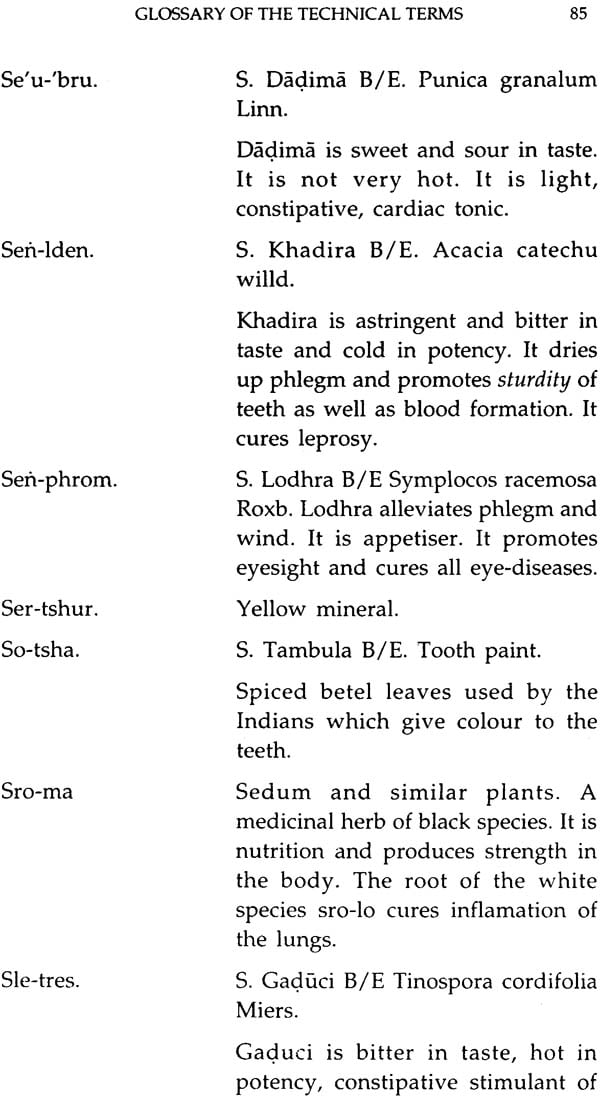
A Heap of Jewels of Oral Radiation (Kha-'Thor Rin-Chen Phun Po of Gyu-Thog Yon-Tan Mgon Po)
Book Specification
| Item Code: | NAD252 |
| Author: | Archana Ray |
| Publisher: | The Asiatic Society |
| Edition: | 2009 |
| Pages: | 136 |
| Cover: | Hardcover |
| Other Details | 8.5 inch x 5.5 inch |
| Weight | 280 gm |
Book Description
Dr. Archana Ray was born at Kolkata. She did her graduation with honours in Linguistics, post- graduation also in Linguistics with specialization in Tibeto Burman Group and P.G. Diploma on Tibetan Language from Calcutta University. She got B.Lisc degree from IGNOU and Certificate in Manuscriptology from the Asiatic Society (1-year course). She did her PhD on Tibetan Manuscript (Critical Appreciation) from Jadavpur University.
She had a vast experience of work on Tibetan manuscripts. She worked as cataloguer of Tibetan manuscripts in the University of Calcutta (1990-93). She has been working as Tibetan Cataloguer in the Asiatic Society since 1993.
Tibetan medical knowledge is primarily based on the old clinical experiences in the observation of the patients. In the Tibetan medical practice medicine is usually taken from the nature and used for a specific method of treatment. Yuthog’s (Gyu-thog yon-tan mgon-po) Kha-’thor rinchen phun-po b ugs-so suggested that it is an overall treatment of the lack of proper balance of these major elements namely wind(rluñ), bile(mkhris), and phlegm(badkan). The text deals specially with the curative aspect of chronic diseases like piles or hemorrhoids gian-’brum, kidney disease mkhal-nad, etc. and simultaneously it describes the measurement of various herbal ingredients used for different diseases and their doses, prevention of diseases, medicinal recipes, preparation of recipes, method of treatment and others.
This work will be of interest both scholars and general readers mostly ‘in the field of Ayurvedic medicine. It is an alternative mode of treatment which is safe as well.
This work, edited by Archana Ray, deals with the Tibetan methods of effecting cure of numerous ailments including the case of Dogbite and Consumption of Poisonous Food. This important work was written by Gyu-thog yon-tan mgonp0 (c. 745-833 A.D.). Reading the contents, translation of the Tibetan text, word-list, technical terms, botanical names, and the bibliography, it is easy to conclude that this work is an authoritative dissertation on Tibetan medicine, the practice of which was prevalent in early mediaeval times. My assumption is that this work would be considered important by the students of Ayurveda. The publication of this work, which has been edited with admirable competence, would, I trust, be useful to the readers.
The Kha-’thor rin chen phun po suggests an oral discourse on the heaps of jewels, in Sanskrit Ratna-puñja-upadea. It is an indigenous treatise on the human health management for the inhabitants of Tibet especially by yu thog (senior) in the 8th century A.D. A brief note about the present chapter of yu thog’s work may be required to introduce, while the Asiatic Society has taken a measure to reopen an ancient chapter of the Asian knowledge on the human healing science. The importance of the present work edited by Dr. Archana Ray of the Society on the curative medicines and methods of their preparations for applications, as yu thog enunciated, is not similar to those in the ancient Indian Ayurvedic order. Because, Vagabhat(t)a’s Aanga hrdaya sathhitã (yan lag brgyad snying po) was rendered in Tibetan later on.
Yu thog endeavoured to locate the causals of a disease usually prior to his prescriptions. He did not overlook the external environs a priori for accumulating disorders of the ailing in the land of snow.
The culture of health management may be regarded essential to the human life. The history of cross cultural interaction between Tibet and India dates back to 7th century AD. Several treatises on health and hygiene were exchanged. The Tibetans gave preference to curative science gso-rig. The Indians also paid importance to Tibetan texts on medicine.
The Asiatic Society, Kolkata is a store-house of a large number of Tibetan texts. Among them a Tibetan manuscript consisting of 113 verses on Tibetan curative science is discussed here.
The text is named as Kha-'thor rin-chen phun-po, a collection from the mass of great jewels. It deals with an overall treatment of diseases. Yu-thog yon-tan gon-po (gyu- thog yon-tan mgon-po) holds that, according to the Buddhist conception, the human body consists of five aspects namely, form, sensation, cognition, previous impressions and consciousness. Those are born of the five primary elements, earth, water, fire, wind and space. A disease means a kind of disorder among the elements. The concept of disorder of the human body depends on causes like wind, bile and phlegm. It manifests itself as a disease affecting even the extremities, hair and nails.
The text in colophon reads that it was deliberated inside the Dga-ldan phun-tshong glin monastery belonging to the Gelukpa (dge lugs pa) sect. This monastery is one of the important monasteries in Tibet. It was a seat of the academic pursuits by the erudite.
A. STUDY MATERIALS :
The Asiatic Society has got only one copy of that manuscript. For sake of comparative editing another copy of the xylograph preserved in Calcutta University is used. That copy is very brittle to handle but it is complete. In the National Library, Kolkata, a copy in a printed book form is preserved. It is edited by Lokesh Chandra from the Sarasvati Vihar, Delhi. The text includes other works of Yu-thog yon- tan gon-po. The details of three sets are :
1. The Asiatic Society collection : Kha-'thor rin-chen phun-po (medicine); Script. dbu-can: Vol. Tha; Folio, la-9a2; size 54x9cm; per page 5-6 lines; hand-made paper; Appearance old, complete.
2. Calcutta University collection : Kha-'thor rin-chen phun-po (medicine); Script.dbu-can; per page 5-6 lines; Hand-made-paper; Vol. Tha; Size 55x9cm; folio. la-9a3. Appearance brittle, complete; wooden block print xylograph.
3. National Library printed collection : Kha-'thor rin- chen phun-po (medicine); script, dbu-can: Vol. Tha; folio. 301a-308a; size 54x9cm; per page 25-27 lines; Appearance good, complete, book form.
B. AUTHOR: GYU-THOG YON-TAN MGON-PO (c. 748- 833 AD):
In the history of the Tibetan medicine Yu-thog yon-tan gon- po Gyu-thog yon-tan mgon-po appeared in the 8th century. He is regarded as a pioneer in developing Tibetan Medicine, a branch of idigene knowledge, distinct from that of China and India. At the outset he. describes the history of the Medical Science in Tibet. He also continues the bio-organs vividly and how to examine the disorderliness, such as the pulses, tongue, liver and urine etc. In Tibet the cold disease is frequent, so its cause and symptoms and their treatments are recorded. Especially different types of poisons, billi disease, fever etc. are dealt.
According to Clifford Terry' the first historical monarch of Tibet Srong btsan sgam so in the 7th century AD invited multiple practitioners for healing to explore a new line of medicine in Tibet. Thus Tibetan Medicine became a unique healing art in which the cross cultural involvement prevailed. Then the king Trison De-tsen : Khri-sron lde-btsan (755-797) of that family evaluated the Tibetan medical tradition. He decided to hold a debate among the contemporary physicians in Asia from Kashmir of India, China, Napal, Mongolia, Sinkiang, Afghanistan for assembling the merits of each tradition. Yu-thog yon-tan gon-po was the representative from Tibet. The Tibetan doctor Yu-thog mgon-po proved to be the supermost. The meaning of yu-thog yon-tan is significant. Yu means turquoise, thog means roof and yon- tan means merit.
By personal initiative, dedication and untiring efforts Yu- thog-yon-tan gon-po produced a number of authoritative treatises and documents on diagnosis and treatment of . diseases with theoretical knowledge and practical techniques of Tibetan Medicine. In this regard he is said to have visited India thrice to compare the Tibetan Medicine with the prevailing Indian system of medicine for further research. Among the well-known works of Yu-thog yon-tan mgon- po, Cha-lag bco-brgyad (lit. eighteen implementations) is the most important which is a general collection. Various medical texts like Dekhor Chobrgyad (a resume), Rotra-tasu gyi-dimeg (on surgery) and sog-dril bskor-gsum contain the finds of his own research and discoveries. In this regard the Indian Ayurvedic texts like Caraka Sathhita and Susruta Samhita dealing on surgery and diagnosis of diseases, might have reached him. He said to have being alive for eighty-five years.
. The period from his yuthog days in life in the eighth century A.D. to that of his namesake yu thog who appeared in twelfth century A.D. is considered by some as the "golden age" of Tibetan Medicine. During that time they acquired more knowledge in medicine from foreign sources, especially India. Yuthog was root physician to set an example among the doctor and physicians of Tibet. The Tibetans traditions believe that the organiser of Medicine as a system is Buddha. Buddha is therefore the king of Medicine, because, according to Buddha's teaching, no disease is unrelated to mind. The Tibetan Medical system recognises the dependent relationship between functions of mind and body. In Tibet an eminent physician is to follow the selfless healing skill. His efficiency is bestowed by Bhaisajjaguru the Medicine Buddha Sman-la bde-gsegs.
| Foreword | vii |
| Preface | ix |
| Preamble | xi |
| Abbreviations | xiii |
| Introduction | 1 |
| Tibetan Text : Kha-’Thor Rin-Chen Phuri-Po | 23 |
| English Translation | 45 |
| Head disease | 45 |
| Hair disease | 46 |
| Eye disease | 46 |
| Nasal disease | 47 |
| Ear disease | 47 |
| Mouth disease | 48 |
| Tooth disease | 48 |
| Inflamation of Uvula | 49 |
| Tongue disease | 49 |
| Sorethroat | 49 |
| Goitre | 50 |
| Pimples on the face | 50 |
| Heart disease | 50 |
| Lungs disease | 51 |
| Liver disease | 52 |
| Infectious diseases | 55 |
| Skin disease | 55 |
| Dysentery | 55 |
| Cataracts | 56 |
| Mouth drying | 56 |
| Hiccup | 56 |
| Piles (Hemorrhoids) | 57 |
| Constipation | 57 |
| Obstruction of urine | 57 |
| Disease of Kidney and genetic organs | 58 |
| Disease of Stomach | 58 |
| Disease of Uterus | 59 |
| Acute Diarrhoea | 60 |
| Skin disease | 60 |
| Damage of bones | 61 |
| Dry skin with ring-worm itch | 61 |
| The fire burn ringworm or the sun cases | 62 |
| Skin disease | 62 |
| Damage of limb, fractures of limb | 62 |
| Dogbite case | 63 |
| Poisonous food eating | 64 |
| Glossary of the Technical Terms | 65 |
| Trilingual Word List Tibetan-Sanskrit-English | 87 |
| Technical Usages Sanskrit - Tibetan | 105 |
| Botanical names corresponding to Tibetan and Sanskrit | 109 |
| Bibliography | 113 |
